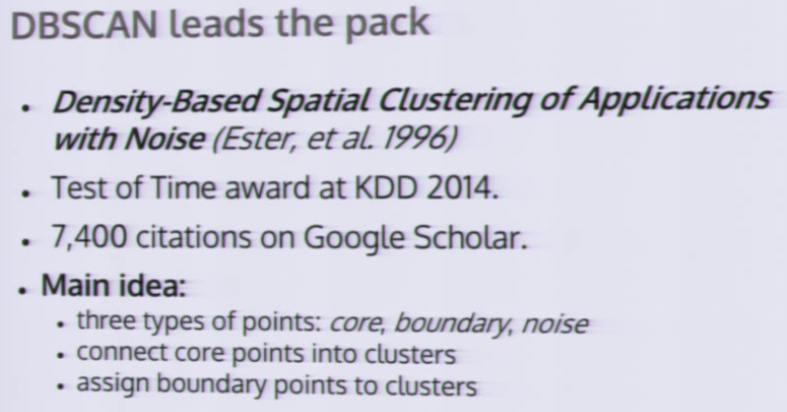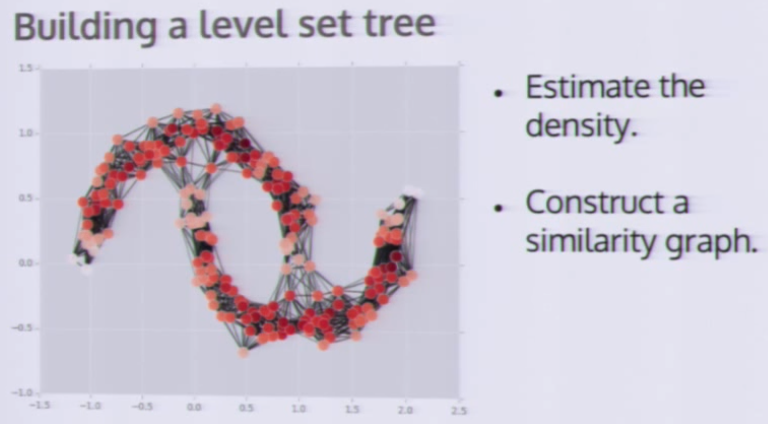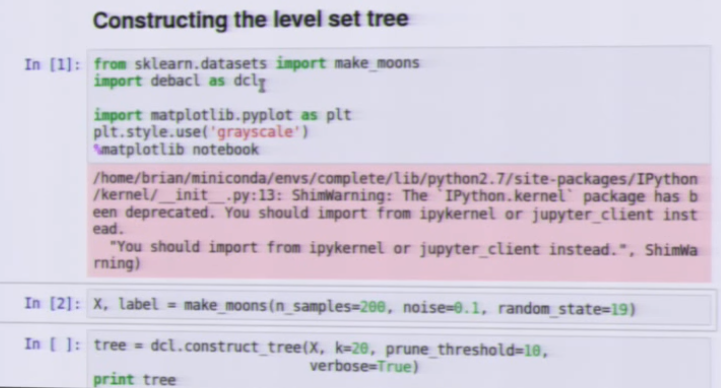[Scikit-learn] *2.3 Clustering - DBSCAN: Density-Based Spatial Clustering of Applications with Noise
http://scikit-learn.org/stable/modules/generated/sklearn.cluster.DBSCAN.html#sklearn.cluster.DBSCAN
From: Brian Kent: Density Based Clustering in Python


聚类演示:https://www.naftaliharris.com/blog/visualizing-dbscan-clustering/
print(__doc__) import numpy as np from sklearn.cluster import DBSCAN
from sklearn import metrics
from sklearn.datasets.samples_generator import make_blobs
from sklearn.preprocessing import StandardScaler # #############################################################################
# Generate sample data
centers = [[1, 1], [-1, -1], [1, -1]]
X, labels_true = make_blobs(n_samples=750, centers=centers, cluster_std=0.4,
random_state=0) X = StandardScaler().fit_transform(X) # #############################################################################
# Compute DBSCAN
db = DBSCAN(eps=0.3, min_samples=10).fit(X)
core_samples_mask = np.zeros_like(db.labels_, dtype=bool)
core_samples_mask[db.core_sample_indices_] = True
labels = db.labels_ # Number of clusters in labels, ignoring noise if present.
n_clusters_ = len(set(labels)) - (1 if -1 in labels else 0) print('Estimated number of clusters: %d' % n_clusters_)
print("Homogeneity: %0.3f" % metrics.homogeneity_score(labels_true, labels))
print("Completeness: %0.3f" % metrics.completeness_score(labels_true, labels))
print("V-measure: %0.3f" % metrics.v_measure_score(labels_true, labels))
print("Adjusted Rand Index: %0.3f"
% metrics.adjusted_rand_score(labels_true, labels))
print("Adjusted Mutual Information: %0.3f"
% metrics.adjusted_mutual_info_score(labels_true, labels))
print("Silhouette Coefficient: %0.3f"
% metrics.silhouette_score(X, labels)) # #############################################################################
# Plot result
import matplotlib.pyplot as plt # Black removed and is used for noise instead.
unique_labels = set(labels)
colors = [plt.cm.Spectral(each)
for each in np.linspace(0, 1, len(unique_labels))]
for k, col in zip(unique_labels, colors):
if k == -1:
# Black used for noise.
col = [0, 0, 0, 1] class_member_mask = (labels == k) xy = X[class_member_mask & core_samples_mask]
plt.plot(xy[:, 0], xy[:, 1], 'o', markerfacecolor=tuple(col),
markeredgecolor='k', markersize=14) xy = X[class_member_mask & ~core_samples_mask]
plt.plot(xy[:, 0], xy[:, 1], 'o', markerfacecolor=tuple(col),
markeredgecolor='k', markersize=6) plt.title('Estimated number of clusters: %d' % n_clusters_)
plt.show()
Result:

补充,一个效果同样好的算法:Level Set Tree

加载方式:
import debacl as dcl

[Scikit-learn] *2.3 Clustering - DBSCAN: Density-Based Spatial Clustering of Applications with Noise的更多相关文章
- scikit learn 模块 调参 pipeline+girdsearch 数据举例:文档分类 (python代码)
scikit learn 模块 调参 pipeline+girdsearch 数据举例:文档分类数据集 fetch_20newsgroups #-*- coding: UTF-8 -*- import ...
- DBSCAN(Density-based spatial clustering of applications with noise)
Density-based spatial clustering of applications with noise (DBSCAN) is a data clustering algorithm ...
- (原创)(三)机器学习笔记之Scikit Learn的线性回归模型初探
一.Scikit Learn中使用estimator三部曲 1. 构造estimator 2. 训练模型:fit 3. 利用模型进行预测:predict 二.模型评价 模型训练好后,度量模型拟合效果的 ...
- (原创)(四)机器学习笔记之Scikit Learn的Logistic回归初探
目录 5.3 使用LogisticRegressionCV进行正则化的 Logistic Regression 参数调优 一.Scikit Learn中有关logistics回归函数的介绍 1. 交叉 ...
- Scikit Learn: 在python中机器学习
转自:http://my.oschina.net/u/175377/blog/84420#OSC_h2_23 Scikit Learn: 在python中机器学习 Warning 警告:有些没能理解的 ...
- Scikit Learn
Scikit Learn Scikit-Learn简称sklearn,基于 Python 语言的,简单高效的数据挖掘和数据分析工具,建立在 NumPy,SciPy 和 matplotlib 上.
- Direction of Arrival Based Spatial Covariance Model for Blind Sound Source Separation
基于信号协方差模型DOA的盲声源分离[1]. 在此基础上,作者团队于2018年又发布了一篇文章,采用分级和时间差的空间协方差模型及非负矩阵分解的多通道盲声源分离[2]. 摘要 本文通过对短时傅立叶变换 ...
- Clustering by density peaks and distance
这次介绍的是Alex和Alessandro于2014年发表在的Science上的一篇关于聚类的文章[13],该文章的基本思想很简单,但是其聚类效果却兼具了谱聚类(Spectral Clustering ...
- 机器学习-scikit learn学习笔记
scikit-learn官网:http://scikit-learn.org/stable/ 通常情况下,一个学习问题会包含一组学习样本数据,计算机通过对样本数据的学习,尝试对未知数据进行预测. 学习 ...
随机推荐
- Linux教程 网络管理命令Netstat的使用
Netstat(network statistics) 网络统计命令是一个命令行工具,用于监视网络出入的连接,路由表以接口统计等.Netstat 在所有的Unix或者Linux系统,Windows系统 ...
- 《流畅的Python》Data Structures--第2章序列array
第二部分 Data Structure Chapter2 An Array of Sequences Chapter3 Dictionaries and Sets Chapter4 Text vers ...
- window open() 方法
open() 方法用于打开一个新的浏览器窗口或查找一个已命名的窗口. 语法 window.open(URL,name,specs,replace) 参数 说明 URL 可选.打开指定的页面的URL.如 ...
- 2019牛客多校第三场D BigInteger——基础数论
题意: 用 $A(n)$ 表示第 $n$ 个只由1组成分整数,现给定一个素数 $p$,求满足 $1 \leq i\leq n, 1 \leq j \leq m, A(i^j) \equiv 0(mo ...
- 17、生命周期-BeanPostProcessor在Spring底层的使用
17.生命周期-BeanPostProcessor在Spring底层的使用 bean赋值.注入其他组件.@Autowired注解.生命周期注解.@Async --都是 BeanPostProcesso ...
- 16、生命周期-BeanPostProcessor原理
16.生命周期-BeanPostProcessor原理 16.1 打断点运行postProcessBeforeInitialization 可以看到先执行的顺序为: applyBeanPostProc ...
- python自动华 (九)
Python自动化 [第九篇]:Python基础-线程.进程及python GIL全局解释器锁 本节内容: 进程与线程区别 线程 a) 语法 b) join c) 线程锁之Lock\Rlock\ ...
- 第八章 用SQL语句操作数据
--切换数据库:手动切换和命令切换 use MySchool --向Student表中插入数据 --语法:INSERT [INTO] 表名 (列名) VALUES (值列表) --注意事项: --1. ...
- 【题解】[Noip2010]机器翻译-C++
题目Description小晨的电脑上安装了一个机器翻译软件,他经常用这个软件来翻译英语文章.这个翻译软件的原理很简单,它只是从头到尾,依次将每个英文单词用对应的中文含义来替换.对于每个英文单词,软件 ...
- 001_Python安装
1. 判断电脑是否已经安装python,电脑->运行->输入:python 2. 如果没有安装,去官网下载:https://www.python.org/downloads/ 3. 安装过 ...
